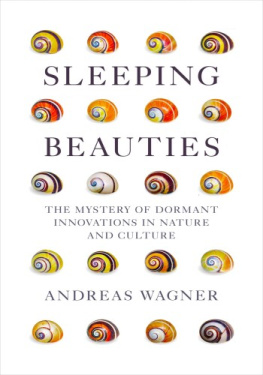The Origins of Evolutionary Innovations
The Origins of Evolutionary Innovations
A Theory of Transformative Change in Living Systems
Andreas Wagner
Institute of Evolutionary Biology
and Environmental Studies
University of Zurich
Switzerland


Great Clarendon Street, Oxford OX2 6 DP
Oxford University Press is a department of the University of Oxford.
It furthers the Universitys objective of excellence in research, scholarship,
and education by publishing worldwide in
Oxford New York
Auckland Cape Town Dar es Salaam Hong Kong Karachi
Kuala Lumpur Madrid Melbourne Mexico City Nairobi
New Delhi Shanghai Taipei Toronto
With offices in
Argentina Austria Brazil Chile Czech Republic France Greece
Guatemala Hungary Italy Japan Poland Portugal Singapore
South Korea Switzerland Thailand Turkey Ukraine Vietnam
Oxford is a registered trade mark of Oxford University Press
in the UK and in certain other countries
Published in the United States
by Oxford University Press Inc., New York
Andreas Wagner 2011
The moral rights of the author have been asserted
Database right Oxford University Press (maker)
First published 2011
All rights reserved. No part of this publication may be reproduced, stored in a retrieval system, or transmitted, in any form or by any means, without the prior permission in writing of Oxford University Press, or as expressly permitted by law, or under terms agreed with the appropriate reprographics rights organization. Enquiries concerning reproduction outside the scope of the above should be sent to the Rights Department, Oxford University Press, at the address above
You must not circulate this book in any other binding or cover
and you must impose the same condition on any acquirer
British Library Cataloguing in Publication Data
Data available
Library of Congress Cataloging in Publication Data
Data available
Typeset by SPI Publisher Services, Pondicherry, India
Printed in Great Britain
on acid-free paper by
CPI Antony Rowe, Chippenham, Wiltshire
ISBN 978-0-19-969259-0 (Hbk.)
978-0-19-969260-6 (Pbk.)
1 3 5 7 9 10 8 6 4 2
If you want to have a good invention,
have a lot of them.
Attributed to T.A. Edison
Acknowledgments
Research is a social endeavor. The research leading to this book is no exception. The books bibliography comprises almost 900 items. This large number reflects the size of my debt to a community that has accumulated the knowledge on which I build. And still, the bibliography is not complete. Any attempt at being exhaustive would have led to a tome many times the current size. Please accept my apologies if your work is not cited here. I did not omit it for willful negligence, but to keep the exposition focused, for the benefit of the non-expert reader.
A significant portion of the book relies on research by PhD students and postdocs in my own laboratory over more than ten years. Their work is cited throughout. No one person could assemble a body of work this size in such a limited time. I am in great debt to my co-workers, not least because of the trust they placed in an unorthodox research program based on innovation. Special thanks also go to my collaborator Olivier Martin. His expertise has been instrumental in analyzing the structure of large genotype spaces.
Allan Drummond, Angela Hay, Miltos Tsiantis, Danny Tawfik, and Nobuhiko Tokuriki have provided illustrations. Several trusted colleagues reviewed individual chapters of this book. They include Homayoun Bagheri, Peter and Rosemary Grant, Lukas Keller, Marcelo Snchez, and Daniel Segr. Thanks to all of them, as well as to Ian Sherman and Helen Eaton for their editorial work. Finally, Johannes Jaeger and Alessandro Minelli, as well as an anonymous reviewer who went far beyond the call of duty, and read and critiqued the entire volume. I followed most of their advice, which helped improve the book considerably. Where I decided otherwise, it may have been for the worse and only I am to blame.
Contents
CHAPTER 1
Introduction
The history of life is a history of innovations. We are all familiar with countless examples, but are there principles behind them? Is there a property that facilitates innovations, regardless of their physical manifestation? I here argue that the answer is yes, and I characterize this propertyI will call it innovability.
Innovations everywhere Every macroscopic organism has visible traits that were dramatic, transformative innovations when they first became fully formed. They changed not only organismal lifestyles, but also the future evolutionary path of life. Examples include plants with flowers, animals with a hard skeleton, birds and insects with wings, organisms living in groups, and, most fundamentally, multicellularity itself. Others include teeth to digest hard foodstuffs, vascular systems of plants and animals, syringes to deliver venoms, the endosperm storage tissues of seeds, and the silk production of arthropods [].
Underneath this surface of macroscopically visible innovations is a universe of microscopic and submicroscopic innovations. Ultimately, they are the basis of all macroscopic innovations. An example is oxygen-producing photosynthesis. It originated with light-harvesting molecules that can split water to produce oxygen, and with mechanisms to incorporate carbon dioxide into biomass. By allowing oxygen to accumulate in the atmosphere, it changed not only the entire geochemistry of the planet, but also the future trajectory of life [].
It may be difficult to define rigorously what an evolutionary innovation is []. However, these and countless other examples show that it is usually easy to recognize: a new feature that endows its bearer with qualitatively new, often game-changing abilities. These may not only mean the difference between life and death in a given environment (just think of biosynthetic abilities), they may also create broad platforms for future innovations, as did the innovations of photosynthesis and of complex nervous systems.
Towards a theory of innovation During Charles Darwins era, molecular innovations were inaccessible to science. In his theory of evolution by natural selection, Darwin thus focused on complex macroscopic innovations, such as our eyes, organs of extreme perfection and complication, which he acknowledged as potential difficulties for his theory [Ch. 6 of ref. 162]. At the same time Darwin emphasized his conviction that such complex innovations could evolve from simpler antecedents through gradual variation that is preserved by natural selection. Since then, eyes have become a textbook example of evolutionary innovation. We now know that they have evolved multiple times independently [].
], Natural selection may explain the survival of the fittest, but it cannot explain the arrival of the fittest. This question about the origins of new things is still fundamentally unanswered. What is it about life that allows innovation through random changes in its parts? This ability becomes especially striking when we contrast it with the properties of most man-made, engineered systems. Would random changes in a typical complex technological system, say, a computer or an airplane, be a sensible recipe to improve the system? Hardly. There is something special about the architecture of life that makes it amenable to improvement through random change. This something is the subject of this book. I here provide evidence that it is more than a combination of natural selection and random change. Both are necessary but not sufficient for innovation.
Next page













